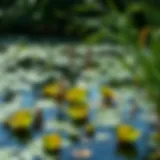The Importance of One Pallet of Bermuda Sod
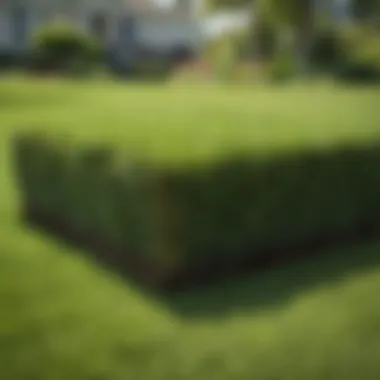

Intro
Bermuda sod has captured the interest of many in the realms of agriculture and landscape management. Its unique characteristics make it a favored choice for various applications, from residential lawns to commercial sports fields. Understanding the value of a single pallet of this grass type is essential for anyone engaging in turf management or landscaping projects.
A pallet of Bermuda sod typically consists of harvested sod strips laid out on a wooden base, making transportation easy. Each pallet can cover an area of approximately 450 to 500 square feet, depending on the thickness of the sod. Thus, its implications in both functionality and cost become apparent when one considers the landscaping and maintenance it requires.
In this examination, we will explore its essential traits, applications, and maintenance requirements, along with practical considerations like costs and environmental advantages. This guide aims to provide both enthusiasts and professionals with a detailed resource on Bermuda sod.
Key Concepts and Terminology
Basic Definitions
Bermuda sod refers to pieces of grass that have been cultivated and harvested for immediate use in landscaping. This variety is known for its vigorous growth and ability to withstand wear, making it popular for lawns and athletic fields.
Historical Context
Bermuda grass has origins in Africa and the Mediterranean region, thriving in warmer climates. Over time, it has been adopted widely in the United States and other regions with similar climates. Its utility in urban landscapes has led to advancements in breeding for enhanced drought resistance and faster growth rates.
Recent Innovations and Trends
Technological Advancements
Recent developments have influenced how Bermuda sod is cultivated. Improved irrigation systems allow for more efficient water usage, while advancements in turf management software enable precise monitoring and maintenance schedules.
Sustainable Practices
There is a growing focus on sustainability in agriculture and landscaping. The use of Bermuda sod contributes to this by requiring less water compared to other grass types, making it suitable for environments aiming to reduce water consumption. Moreover, integrated pest management (IPM) practices have become more common, reducing the reliance on chemical pesticides.
Practical Applications and Techniques
Step-by-step Guides
- Preparation: Clear the area of debris, weeds, and old grass. Level the soil to create a flat surface.
- Soil Testing: Assess the soil's nutrient content and pH to correct any deficiencies before laying sod.
- Installation: Lay the sod in staggered rows, ensuring tight seams to prevent gaps. Water immediately after installation.
- Maintenance: Follow a regular schedule of watering, mowing, and fertilization to keep the lawn healthy.
Case Studies
A local sports complex adopted Bermuda sod for its fields. The decision was based on its durability and ability to recover quickly from heavy use. A year later, the management reported a significant reduction in maintenance costs and an increase in user satisfaction due to the enhanced appearance and resilience of the fields.
"Bermuda sod is not just a type of grass; it's a sustainable solution for a greener environment while offering beauty and functionality."
Prelims to Bermuda Sod
Bermuda sod is recognized for its adaptability and popularity in various settings, making it essential in the world of landscaping and turf management. This section will outline the crucial elements of Bermuda sod, emphasizing its characteristics and applications.
Defining Bermuda Grass
Bermuda grass (Cynodon dactylon) is a warm-season turfgrass native to tropical and subtropical regions. It is known for its fine texture and dense growth, which provides an appealing aesthetic. This grass thrives in sunny environments, requiring a minimum of six to eight hours of sun daily. Additionally, its rapid growth rate contributes to quick recovery from wear and tear, making it a favored choice for many property owners.
Bermuda grass has various cultivars, each chosen for specific situations based on their resilience and appearance. Some popular varieties include ‘Celebration’, ‘Tifway 419’, and ‘Princess 77’. These variations can influence aspects from color to drought tolerance, providing options depending on the particular lawn or golf course design.
Common Uses of Bermuda Sod
Bermuda sod serves multiple purposes. Here are some of its most common applications:
- Residential Lawns: Homeowners often prefer Bermuda sod for its lush appearance and durability.
- Sports Fields: Many sports fields utilize Bermuda grass because it can withstand heavy foot traffic and recover rapidly, ensuring a playable surface.
- Golf Courses: The grass is a popular choice on golf courses, particularly for tees and fairways, due to its smooth surface and stability.
- Parks and Recreational Areas: Public spaces benefit from Bermuda sod because it supports active use and effective drainage.
In addition, Bermuda sod is often employed in eco-friendly landscaping solutions. Its drought resistance and adaptability to local climates make it a wise choice for sustainable practices.
Bermuda sod is a versatile choice suitable for various applications, enhancing both aesthetic and practical value in landscaping.
Understanding a Pallet of Sod
Understanding what constitutes a pallet of sod is vital for anyone working with Bermuda sod. A pallet serves as a standard unit in the sod industry, simplifying the purchase, storage, and installation process. Knowing its dimensions and coverage can greatly impact how effectively you use Bermuda sod in various applications. This section will explore the essence of what a pallet is, and its typical dimensions, further illuminating the practical value of one pallet of Bermuda sod.
What Is a Pallet?
A pallet, in the context of sod, refers to a wooden structure used as a base for transporting and storing rolls or slabs of sod. It enables easier handling and movement of substantial quantities of sod, essential for both suppliers and consumers. These pallets usually hold sod that is pre-grown, meaning it is ready for installation.
The use of pallets provides benefits such as:
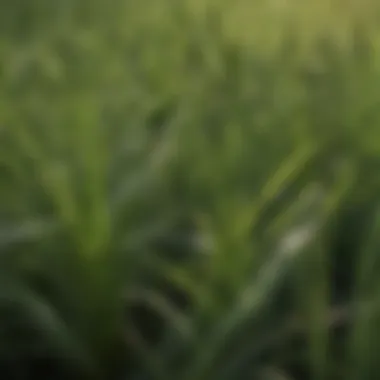

- Standardization: A pallet typically includes a uniform amount of sod, making it easier for buyers to understand how much they are purchasing at one time.
- Protection: Elevating sod off the ground through pallets prevents damage from moisture and pests, safeguarding the quality of the product.
- Efficiency: Handling and transporting sod in bulk is more efficient than trying to manage individual pieces, especially during delivery or a DIY project.
Typical Dimensions and Coverage
Pallets of Bermuda sod are generally standardized in terms of size, which can vary by region or supplier. Most commonly, a pallet measures about 2 feet by 5 feet or 3 feet by 6 feet. In terms of coverage, one pallet typically covers approximately 450 square feet of soil when the sod is laid down correctly. This means professionals and homeowners alike can estimate how many pallets are needed based on the area that requires sod installation.
Factors that influence the effective coverage include:
- Installation density: Different installation techniques, such as staggered or aligned methods, can affect the total coverage area.
- Sod thickness: Thicker rolls may require additional space between pieces, slightly reducing overall coverage.
Understanding these dimensions is crucial for calculating the quantity of Bermuda sod required for any landscaping project. This knowledge can also help avoid unnecessary expenditures, ensuring optimal use of resources.
Benefits of Using Bermuda Sod
Exploring the benefits of using Bermuda sod is crucial for anyone considering a landscaping project or turf management. The advantages go beyond mere aesthetics and cover practical aspects that can significantly influence a project's success. Understanding these benefits helps in making informed decisions regarding the selection and application of Bermuda sod in various settings.
Rapid Establishment
One primary advantage of Bermuda sod is its ability to establish quickly. Compared to seed, which can take several weeks to germinate and grow, sod allows for immediate coverage. When properly installed, Bermuda sod can root into the soil within a week, providing an instant green surface. This rapid establishment is especially beneficial for homeowners and businesses wanting quick results following installation. Moreover, it minimizes soil erosion during that establishment phase, which is a common concern with seeding.
There are several factors that contribute to the quick establishment of Bermuda sod:
- Root Structure: The dense root structure allows for better nutrient uptake and moisture retention.
- Minimal Competition: Newly laid sod faces less competition from weeds, making it easier for the grass to grow.
- Temperature Adaptability: Bermuda grass thrives in warm climates and can establish rapidly when temperatures are conducive, usually in spring and early summer.
Drought Resistance
Bermuda sod exhibits impressive drought resistance. Once established, Bermuda grass can endure dry spells better than many other grass types. This characteristic makes it an excellent choice for regions where water conservation is prioritized. The grass possesses a unique physiological adaptation that helps it sustain during dry periods. For instance, when water becomes scarce, Bermuda grass can enter a dormant state, slowing down its growth while retaining moisture.
Factors that enhance the drought resistance of Bermuda sod include:
- Deep Root System: A developed root system reaches deeper soil layers for water, enabling it to survive extended dry conditions.
- Heat Tolerance: Bermuda grass tolerates high temperatures, reducing the need for frequent irrigation.
- Efficient Water Use: This grass type utilizes water efficiently, minimizing waste during irrigation.
Many landscape designers and turf managers turn to Bermuda sod, knowing its durability will provide a sustainable solution to water challenges while maintaining a vibrant lawn.
Aesthetic Appeal
Aesthetic appeal is another significant benefit of Bermuda sod. Homeowners and landscape designers appreciate its fine texture and lush green color, which contribute to a well-manicured look. Bermuda grass has a dense growth habit that offers a lush appearance, making it suitable for both residential and commercial properties. Its uniformity is often favored in lawns and sports fields, where visual impact is crucial.
Some key points regarding the aesthetic advantages of Bermuda sod include:
- Versatility: It fits various landscape styles, from formal gardens to casual yards.
- Color Variations: Bermuda grass remains vibrant throughout the growing season, providing a rich green appearance.
- Durable Surface: The hardness of Bermuda grass makes it suitable for high-traffic areas such as sports fields, retaining its look even with extensive use.
"When selecting sod, the visual impact is as vital as practicality; Bermuda sod strikes an impressive balance between both."
Cost Considerations
Understanding the costs associated with a pallet of Bermuda sod is crucial for agricultural farmers and landscaping enthusiasts. This section illuminates how price variability can affect purchasing decisions and highlights the long-term value that can be derived from investing in quality Bermuda sod.
Price Variability
Price variability in Bermuda sod can stem from various factors. First, the region where the sod is sourced plays a significant role. Prices may fluctuate based on local availability, demand, and shipping costs. For instance, sod farms in states like Florida or Texas, known for their production, might offer lower prices than those in areas where Bermuda grass is less common.
Seasonality also affects prices. The demand for sod peaks during spring and summer months when landscaping projects are most common. At these times, one might find prices higher due to increased requests and limited supply. Conversely, during fall and winter, prices can decline as demand wanes.
Another factor to consider is quality. High-quality Bermuda sod, which is free from pests and diseases, may carry a premium price. This initial investment may seem high but can lead to cost savings in the long run due to lower maintenance requirements.
Here are a few elements that contribute to price variability:
- Geographic location of sod production
- Seasonal demand fluctuations
- Varying quality levels of the sod
- Additional shipping and handling costs
Long-Term Value
Investing in Bermuda sod is not only about the upfront costs; it is also about understanding the long-term value. Quality Bermuda sod can enhance the aesthetics of any landscape, but more importantly, it serves functional purposes that transcend its initial purchase price.
One of the significant advantages of Bermuda sod is its resilience. Once established, this grass type requires less water and fertilization compared to some other varieties. Consequently, over time, these savings can offset the initial investment. Furthermore, Bermuda sod's ability to withstand drought conditions further reinforces its value, especially in regions with variable rainfall.
In addition, Bermuda sod quickly establishes a lush lawn, minimizing the time and resources needed for seeding. This can lead to faster usage of the area, which is especially vital for sports fields or commercial landscapes.
Moreover, consider the contribution to property value. A well-maintained sod lawn can enhance the curb appeal of a property, positively impacting its overall market value.
Ultimately, while initial costs might be a concern, the longevity, ease of care, and aesthetic allure of Bermuda sod often justify the expense.
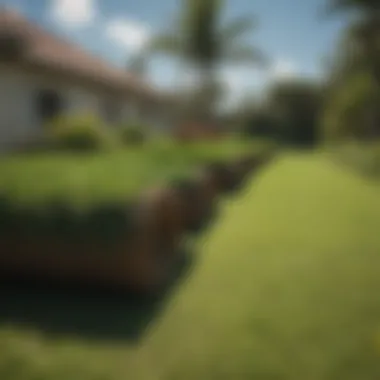

"A quality investment in Bermuda sod yields multiple payoffs down the line, from savings on maintenance to improved property aesthetics."
By examining these cost considerations, readers can make informed decisions that align with both their budget and long-term landscaping goals.
Installation Process
The installation process of Bermuda sod is a critical aspect to consider for anyone looking to create or rejuvenate a lawn or landscape. This phase not only involves the physical application of the sod but also sets the foundation for the long-term success and health of the grass. Proper installation ensures that the sod adapts well to the environment and displays the desirable characteristics that Bermuda grass is known for. Key steps include site preparation, careful laying of the sod, and following proper initial watering guidelines.
Preparation of the Site
Before laying Bermuda sod, preparation of the site is essential. This process includes several specific actions:
- Clearing the Area: Remove any existing grass, weeds, or debris from the land. This will minimize competition for nutrients and water, allowing the new sod to establish itself without hindrance.
- Soil Testing: Conducting a soil test can provide insight into the pH levels and nutrient content. This information is crucial as it informs what amendments might be necessary to promote healthy grass growth.
- Amendments and Tilling: Based on the soil test results, amendments like compost or fertilizers should be added. Tilling helps integrate these amendments into the soil, enhancing nutrient availability.
- Grading the Soil: This involves leveling the surface to prevent water pooling and ensure that the sod lays flat, which is vital for even growth. Proper drainage is a significant factor in the long-term health of the sod.
After completing these steps, the site will be ready for the installation of the Bermuda sod.
Laying the Sod
Laying the Bermuda sod should be approached with care and precision. The procedure involves:
- End-to-End Placement: Begin laying the sod along a straight edge, such as a driveway or path, ensuring that each piece touches but does not overlap the next. This helps create a seamless appearance.
- Staggering Seams: Similar to laying bricks, staggering the seams between pieces of sod will help improve stability. Each piece should be laid out to ensure that joints do not align.
- Trimming Edges: Use a sharp knife or garden spade to trim the edges of the sod as needed to fit the contours of your landscape. Properly fitted sod has a better chance of establishing itself.
- Rolling After Installation: Some recommend rolling the sod after laying it down to ensure it makes good contact with the soil beneath. This can help eliminate air pockets that might impede rooting.
Initial Watering Guidelines
Watering is a critical part of the installation. Proper hydration helps the sod to establish quickly. Here are some guidelines to follow:
- Immediate Watering: Water the newly laid sod immediately after installation to help settle the soil and sod into place. This ensures that it begins the absorption process right away.
- Frequent Light Waterings: For the first week, water the sod lightly but frequently. Aim for about 1 to 2 inches of water per week, divided into several watering sessions each week. This mimics natural rainfall and encourages strong root growth.
- Monitoring Soil Moisture: Check the soil beneath the sod. If it feels dry about an inch beneath the surface, it's time to water again. Avoid overwatering, as it can push the sod up and create air pockets.
"The success of Bermuda sod installation rests largely on the preparation and initial care. By following the outlined steps, you lay the groundwork for a vibrant and healthy lawn."
Following these processes, the installed sod can develop robust roots, ensuring a strong establishment and continued growth. Proper installation of Bermuda sod not only enhances the aesthetics but also contributes to the sustainability and functionality of outdoor spaces.
Maintenance Requirements
The maintenance of Bermuda sod is essential to ensure its health and longevity. Understanding the maintenance requirements helps in optimizing the growth, visual appeal, and resilience of the grass. Regular maintenance plays a critical role in sustaining the turf's overall quality and performance, especially in varying climatic conditions.
Watering Practices
Watering is fundamental to the survival and growth of Bermuda sod. Generally, Bermuda sod needs about one to one and a half inches of water per week, depending on local weather conditions. Early morning is the best time to water. This minimizes evaporation and ensures that the moisture reaches the roots effectively.
When establishing new sod, it is vital to keep the soil consistently moist for the first few weeks. After that, the frequency of watering can be decreased, but the depth of watering should be increased. Observing the color and texture of the grass can indicate if it needs more water. Yellowing or a dry, brittle texture often points to underwatering.
Fertilization Schedule
Fertilizing Bermuda sod appropriately supports its growth and enhances its color and density. A balanced fertilizer with equal parts nitrogen, phosphorus, and potassium is generally advisable. During the growing season, typically from late spring through summer, Bermuda grass benefits from fertilizer applications every six to eight weeks.
In the early spring, a slow-release fertilizer is preferred to give the grass a strong start. Mid-summer applications can focus on nitrogen, which promotes lush growth. However, caution is necessary not to over-fertilize, as excessive nutrients can lead to disease and can negatively impact the environment.
Mowing Guidelines
Mowing is crucial for maintaining the appearance and health of Bermuda sod. The ideal mowing height is between one to two inches. Keeping the grass at this height encourages lateral growth and develops a denser turf while minimizing weed growth.
Regular mowing is necessary, especially during the peak growing season. This practice helps prevent the grass from becoming too long, which can lead to problems like thatch build-up. Always ensure the mower blades are sharp to make clean cuts and avoid stress on the grass. Following a mowing schedule that varies depending on growth patterns will result in a robust lawn.
Key Takeaway: Proper maintenance of Bermuda sod, which includes consistent watering, a well-planned fertilization schedule, and regular mowing, is essential for maximizing its health and aesthetic value.
Innovative Uses of Bermuda Sod
Bermuda sod offers a wealth of innovative applications that go beyond traditional landscaping. By exploring these uses, one can understand its versatility and value in a range of settings. This section aims to highlight projects and practices that recognize Bermuda sod’s benefits, addressing the growing interest in sustainable and efficient landscaping solutions.
Eco-Friendly Landscaping
Using Bermuda sod in eco-friendly landscaping initiatives is increasingly recognized for its sustainability. As a warm-season grass, Bermuda thrives in sunny conditions, requiring less water compared to other grass varieties. This attribute aligns well with modern landscaping goals, aiming to reduce water consumption.
Moreover, Bermuda sod can improve soil health by promoting biodiversity. Its deep roots can anchor the soil, thus preventing erosion while enhancing nutrient absorption. This can play a crucial role in maintaining a healthy ecosystem in residential or commercial gardens.
Benefits of Eco-Friendly Landscaping with Bermuda Sod:
- Reduced Water Usage: Helps in conserving water resources.
- Soil Improvement: Enhances ecological balance by preventing erosion.
- Biodiversity Support: Attracts beneficial insects and wildlife.
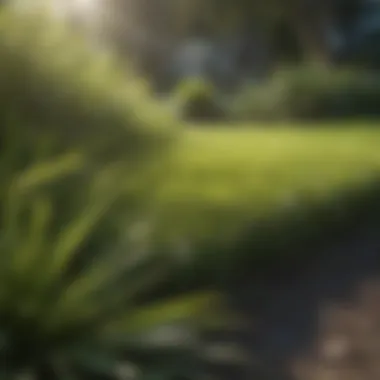

The use of Bermuda sod in eco-friendly practices encapsulates the essence of modern landscaping. It is not just about aesthetics but also about promoting sustainability.
Use in Sports Fields
Another prominent use of Bermuda sod is in the construction of sports fields. Its resilience to foot traffic makes it an ideal choice for sports activities such as football, soccer, and golf. The sod can recover quickly from wear and tear, ensuring a playable surface throughout the season.
In addition to its durability, Bermuda sod also provides players with a safe and even surface. This characteristic minimizes the risk of injuries caused by uneven terrain. Furthermore, its fast establishment rates mean that facilities can prepare a field in a short timeframe, allowing for quicker usability.
Advantages of Bermuda Sod in Sports Fields:
- Durability: Stands up to intensive use without significant damage.
- Safety: Provides a consistent playing surface for athletes.
- Rapid Growth: Ideal for quick field installations and restorations.
Innovative applications of Bermuda sod can lead to cost-effective and sustainable solutions for various landscaping and sporting needs. Understanding these uses emphasizes the broader value that a single pallet of Bermuda sod can offer.
Challenges in Cultivation
Cultivating Bermuda sod presents certain challenges that practitioners must understand to optimize its value. These challenges can significantly affect the health and viability of the turf. Recognizing these challenges is crucial not only for achieving the desired aesthetic but also for ensuring long-term sustainability and performance.
Pest Management
Pest management is a vital aspect of Bermuda sod cultivation. Various pests can invade Bermuda grass, leading to significant damage. Common pests include armyworms, sod webworms, and grubs. These pests may weaken the turf, making it vulnerable to diseases and environmental stresses.
Effective pest management strategies entail both preventive and reactive measures. One popular method is the application of control products, such as insecticides, when pest activity is detected. Regular monitoring of the turf is paramount in this respect. The following techniques can be effective:
- Cultural Practices: Maintaining healthy grass through proper watering, fertilization, and mowing can deter pests.
- Biological Control: Utilizing natural predators, such as certain beneficial insects, can help keep pest populations in check.
- Chemical Control: In severe cases, integrated pest management systems may include judicious use of pesticides to protect the turf.
Careful management of pest populations not only protects the sod but also contributes to a healthier lawn overall. Understanding the lifecycle of specific pests allows for better timing and effectiveness in management strategies.
Disease Resistance
Alongside pests, diseases pose a significant threat to the growth of Bermuda sod. Common diseases affecting Bermuda grass include brown patch, dollar spot, and rust. These conditions can lead to unsightly patches and reduce the overall vigor of the turf.
To mitigate the impact of diseases, it is essential to understand key factors contributing to their prevalence. Healthy growing conditions, such as well-drained soils and appropriate watering techniques, can minimize disease risks. One method to enhance disease resistance is adopting optimal cultural practices.
Some tips for boosting disease resistance include:
- Water Appropriately: Watering early in the morning reduces time spent wet and prevents disease formation.
- Mow Correctly: Maintaining the recommended height for Bermuda grass can reduce stress and disease susceptibility.
- Fertilize Wisely: A balanced fertilization program can promote overall health, making the sod less vulnerable to disease.
Maintaining disease resistance is an ongoing effort that requires vigilance and adaptability to changing conditions. By understanding the challenges posed by pests and diseases, cultivators of Bermuda sod can better appreciate the full value of their turf.
Environmental Considerations
Environmental considerations related to Bermuda sod are essential to discussions about its cultivation and use. Many professionals in landscaping, agriculture, and horticulture recognize the significance of understanding how this sod interacts with the surrounding ecosystem. Such insights can help optimize its use while minimizing negative impacts on the environment. This section will delve into two crucial aspects: the impact of Bermuda sod on soil health and its role in water conservation.
Impact on Soil Health
Bermuda sod contributes positively to soil health. One key benefit is its ability to improve soil structure. When Bermuda grass is planted, its root systems create channels in the soil, promoting air circulation and enhancing the soil’s ability to retain moisture. Healthy soil plays a vital role in supporting plant growth and reducing erosion. Moreover, Bermuda sod aids in the development of healthy microbial communities. These microorganisms are essential for nutrient cycling and can help plants access valuable minerals.
"Healthy soil is the foundation of flourishing landscapes."
Implementing Bermuda sod can also help break down compacted soil. Compaction occurs due to foot traffic or heavy machinery, leading to reduced water infiltration and root growth. The penetrating roots of Bermuda grass help alleviate compacted soil, enhancing overall soil porosity. Furthermore, Bermuda sod sequesters carbon, contributing to the mitigation of climate change effects. In sum, nurturing Bermuda grass not only sustains the plants above but also fortifies the planet’s health beneath.
Water Conservation Benefits
Bermuda sod offers significant advantages for water conservation. This grass variety has innate drought resistance, making it a preferred choice in arid regions. Its deep root system allows it to access moisture from the soil more effectively than some other grass types. As a result, it requires less frequent irrigation once established, reducing water consumption in landscaping projects.
Using Bermuda sod can lead to water savings of up to 50% compared to traditional grass species. This reduction in water usage not only lowers costs for homeowners and businesses but also lessens the strain on local water resources, particularly in drought-prone areas.
In the broader context, promoting water-wise landscaping practices contributes to sustainable development. By selecting Bermuda grass, landscape professionals can support local environments and ecosystems while fulfilling aesthetic and functional demands. Therefore, the integration of Bermuda sod into landscaping plans aligns with a more sustainable approach to resource management.
Ending
The conclusion serves as a crucial element of the discussion surrounding the value of one pallet of Bermuda sod. It synthesizes the key findings and insights explored throughout this article. Understanding these aspects is essential for anyone looking to implement Bermuda sod in their landscaping projects or turf management. The value of one pallet of Bermuda sod transcends mere cost considerations; it encompasses benefits related to aesthetics, environmental impact, and long-term maintenance.
Summary of Key Points
In summary, several critical points emerge from our analysis:
- Benefits of Bermuda Sod: The rapid establishment and aesthetic qualities make Bermuda sod a top choice for many landscapes.
- Installation Considerations: Proper preparation of the site and adherence to watering guidelines are key for successful installation.
- Maintenance Requirements: Regular watering, fertilization, and mowing are paramount for keeping Bermuda sod healthy.
- Environmental Benefits: Using Bermuda sod contributes positively to soil health and aids in water conservation efforts.
This summary encapsulates the primary advantages and challenges associated with Bermuda sod, showcasing its multifaceted value.
Future Trends in Bermuda Sod Usage
Looking ahead, the future of Bermuda sod usage appears promising, driven by evolving agricultural practices and landscape design trends.
- Sustainable Practices: There is a growing trend towards eco-friendly landscaping solutions, where Bermuda sod plays a significant role. Its drought resistance and low maintenance requirements align well with sustainability goals.
- Technological Advances: Innovations in cultivation and maintenance techniques could enhance the efficiency and effectiveness of Bermuda sod. For instance, precision agriculture technology may optimize water and nutrient use.
- Urban Landscaping: As urban areas expand, the need for functional yet attractive green spaces rises. Bermuda sod’s resilience and adaptability make it suited for various urban landscaping applications.














